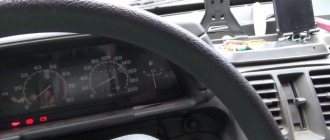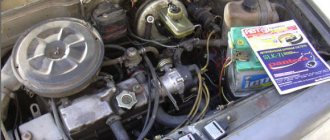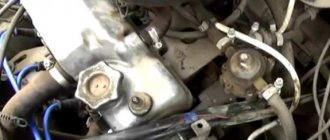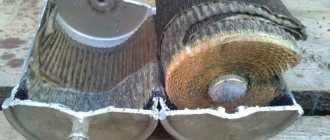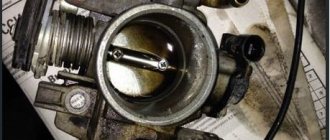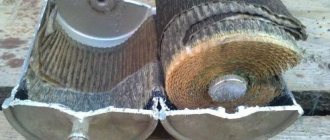The reason for interruptions in engine operation when pressing the brake pedal is most often associated with a violation of the proportions of the air-fuel mixture (AFM). Let's look at how to determine why the engine stalls when braking, shifting to neutral, or suddenly releasing the gas. Let's focus on finding air leaks, checking the vacuum booster and power system.
Why is it possible to leak air through the vacuum booster?
A faulty vacuum brake booster is the most common reason why a car stalls when braking. A flexible diaphragm is installed inside the amplifier housing, which is connected to the brake pedal through a rod. The diaphragm divides the body into two parts:
- vacuum chamber (always connected to the source of vacuum - the engine intake manifold);
- atmospheric chamber.
In the initial position, both chambers are connected through a valve to a source of vacuum. When you press the brake pedal, the valve closes the communication between the chambers and opens the atmospheric part of the amplifier to the atmosphere. The resulting pressure difference overcomes the force of the return spring and acts on the diaphragm, causing it to retract towards the master cylinder.
If the car stalls when braking on gas, but similar symptoms do not occur on gasoline, the problem is in the settings of the gas equipment, so you should not waste time checking air leaks.
Noise when braking
High-frequency noise, squealing, and whistling can occur both during braking and, sometimes, during normal movement. The reason is the off-design mode of friction of the friction material on the working surface of the brake disc. Extreme wear on the brake pads and severe corrosion of the brake disc (often on the inside, “invisible” side) may be to blame. It happens that the brake pad lining has peeled off from the base. The list of possible causes continues with contamination of the pads, warping of the disc due to local overheating, improper fastening of the pads in the caliper, left pads or discs, etc.
Vacuum leaks
When braking, the engine loses its speed and stalls if unaccounted air enters the intake manifold through the line or the brake booster itself. The most common places for vacuum loss are:
- torn brake booster diaphragm. Due to constant temperature changes and operating cycles, rubber loses its elasticity and cracks. Often in the initial state, the air leak will be insignificant and does not affect the operation of the car, but when braking, the engine stalls, since due to the retraction of the diaphragm, the tear area expands;
- Check valve body cracked. The valve allows air only in one direction, which prevents rapid loss of vacuum after stopping the engine;
- leakage of the joint between the diaphragm and the vacuum booster housing;
- a crack in the tubes, hoses going from the intake manifold to the amplifier and other elements of the vacuum system.
Air leaks often begin after repair work in the engine compartment. Unbeknownst to themselves, craftsmen can pull the vacuum hose off the fitting or simply forget to put it on during assembly.
The car stalls when the clutch is depressed: do-it-yourself repair
As a rule, some of the problems associated with a stalling engine can be solved independently in a regular garage. The owner of many cars can clean the throttle himself, replace the fuel pump, filters, spark plugs, high-voltage spark plug wires, ECM sensors, etc.
Currently reading:
Metal conditioners and revitalizants for engines: is it worth it...
Feb 27, 2020
Checking the quality of engine oil: what you need to know...
Feb 27, 2020
Let's look at the most common operations in relation to gasoline cars. These include replacing the idle speed sensor or IAC (idle speed control). Note that on different cars the installation location of these elements may differ, but the replacement itself is almost identical.
The first step is to remove the terminals from the battery. Next, it is determined where the XX sensor is located. Then a chip with wires snaps off from it, which is secured with a latch. Next, unscrew the screws securing the regulator from the throttle pipe, after which the element is removed. Now the new sensor is put in place
During installation, it is important to ensure that the rubber sealing elements on the sensor (if any) fit tightly to the surfaces. Now the sensor, after installation and connection, needs to be calibrated. To do this, you need to put the terminals on the battery and turn on the ignition for 5-15 seconds
Then the ignition is turned off, after which you can test run the internal combustion engine.
As you can see, no difficulties arise if you need to replace the IAC. The process of cleaning the throttle valve is somewhat more complicated. To complete the task, you first need to purchase a special cleaner (carburetor cleaning liquid is suitable). Next, the throttle assembly is removed (in order to remove the element, separately study the repair manual for a specific car).
After dismantling the unit, use a cleaning fluid to wash the throttle valve and channels
Please note that you also need to blow out the crankcase ventilation channel (this can be done using a compressor by supplying air under pressure into the channel)
Also, during the process of removing the throttle, you need to carefully inspect the rubber seals of this unit. If the gasket is damaged, deformations, cracks, tears and other defects are noticeable, then the element needs to be replaced.
The throttle position sensor may also need replacement. To replace the TPS, you need to find this element (often it is located on the throttle pipe). The sensor is attached with ordinary screws that can be unscrewed with a screwdriver.
After this, a new sensor is installed in place. Typically, replacing the TPS solves the problem when the car stalls when you press the clutch, when braking the engine, or when you press the brake pedal.
As for fuel air filters, they also need to be inspected and changed if necessary. Replacing the air filter is not difficult, since you just need to unscrew the cover of the filter housing, remove the old filter element and install a new one. The main thing is to choose the correct size air filter and place it sideways.
When it comes to the fuel filter, you should first locate the fuel pump fuse in the fuse box and turn it off. Then you will need to start the engine. As a result, the fuel pump will not work, the pressure in the power system will drop and the internal combustion engine will soon stall.
Next, you need to find a fuel filter (on different cars it is installed in the engine compartment, in the lower part of the car outside on the bottom, in the area of the gas tank, etc. Often the filter is attached with steel clamps, screwed with screws, etc. Fuel filters are also attached to the filter housing pipes that are removable. Keep in mind that gasoline may leak out of the filter when removed.
When installing a new filter, there should be arrows on the housing that indicate how to correctly position the filter element. The arrows should show the direction of fuel movement from the fuel tank to the engine.
After installing the filter and tightening all the fasteners, turn on the fuel pump by reinstalling the fuse, then you can turn on the ignition for 3-5 seconds so that the fuel pump raises the pressure in the system. After this, the engine can be started.
When the engine is running, you need to again inspect the installation location of the fuel filter. No fuel leaks are allowed at the connection point of the fuel pipes or along the filter housing.
How to check the vacuum booster?
If the vacuum seal is faulty, the brake pedal becomes “stiff”, and more effort is required to stop the car. Often, when you smoothly press the gas, you can hear a characteristic hissing sound from the amplifier, indicating air leakage into the vacuum chamber.
The easiest way is to make sure that the car stalls when you sharply press the brake pedal due to the vacuum booster, using the method of elimination. Disconnect the pipe leading from the manifold to the vacuum chamber, while plugging the inlet hole. If the car stops stalling or stalling when releasing the gas and braking, the direction has been chosen correctly and all that remains is to localize the cause. To do this, reconnect the vacuum line to the manifold, but disconnect the hose from the amplifier, and then plug it with a suitable plug. If the problem with speed does not go away, the reason is air leakage along the vacuum line. If the symptoms disappear, the cause of the stalling engine is a faulty amplifier.
With the engine off, press the brake pedal 3-4 times to equalize the pressure in the chambers. Keep the pedal depressed and start the engine. If the vacuum membrane is intact, the pedal will fall a few centimeters and become noticeably softer.
The vacuum brake booster cannot be repaired and in case of failure must be replaced with a new one.
Hydraulic vacuum hose is one of the causes of failure
To establish a more precise cause of the breakdown, it is necessary to visually inspect the vehicle. It is advisable to diagnose the machine in order. You can start with the vacuum hose. To check its integrity, you must first turn off the engine and then pump the brake pedal 6 times.
During the final action, the pressed brake pedal should remain concave to the floor. After this, you can start the engine. If the vehicle pedal returns to the opposite position, this indicates that the vacuum pump is functioning properly.
If the pedal does not tend to return to its previous position, then you need to look for a leak. Most often, a leak occurs in the area where the hose is fixed to the amplifier or manifold. If liquid is found on the hose itself, this indicates that this is where the cause of the problem lies.
Influence of unaccounted air
For normal engine operation, the composition of the air-fuel mixture (AFM) should not be much more or less than the stoichiometric composition - 14.7 portions of air to 1 portion of fuel. To adjust the injector open time, it is important for the Engine Control Module to know the amount of oxygen entering the cylinders during the intake stroke. Calculation methods differ in the type of sensors, based on the readings of which the weight of the air charge is calculated.
- An absolute pressure sensor (MAP) paired with an air temperature sensor (ATS). The ECU fuel maps contain the flow area of the engine intake system. Based on the vacuum level in the intake manifold and the air temperature, the engine control unit can adequately calculate the mass of the fresh air charge.
- Mass air flow sensor (MAF). The sensor is based on a heater installed in the intake tract after the air filter. The heater temperature is maintained at the specified level. The stronger the airflow, the more current is required to maintain the temperature of the heating element. By measuring the current, the ECU calculates the amount of air entering the intake tract.
If the actual amount of air entering the cylinders is greater than the calculated value calculated by the ECU based on the readings of the mass air flow sensor, the composition of the fuel injection system will be disrupted. Therefore, the engine stalls when the brake pedal is pressed if there is a leak in the vacuum system.
Inertia of injectors on an injection machine
Cleaning a removed injector
In the case of an injection engine, the reason lies in the inertia of the injectors. They do not have time to close at the moment of sudden braking, and fuel overflows under the piston, preventing the occurrence of a spark. As a result, the engine stalls. This suggests flushing (with high-quality gasoline) the fuel equipment and purging the line to prevent dirt from re-entering the filter nozzle nozzles.
So the function of an injector, for example VAZ-2114, is tied to sensors:
- Throttle valve position (TPV).
- Mass air flow (MAF).
- Coolant temperature (CLT).
- Crankshaft position (CPCP).
The first is designed to regulate the volume of air supplied to the engine. The cause of the malfunction is sticking of the damper, mechanical wear with jamming and cutting off the supply of the combustible mixture . A sensor defect is determined with a multimeter to identify a problem in the electrical circuit. The sensor must respond to gas supply. Lack of response leads to replacement of the device.
The second factor in stopping the engine is excessive gasoline consumption, especially when the accelerator pedal is depressed, that is, the gas is pressed or released. The situation boils down to an increase in the amount of air, which becomes a sign of a lean mixture and the engine stopping. The problem is solved by cleaning the sensor.
The third reason occurs when the engine is warm, that is, when a rich mixture is supplied. In this case, the sensor does not produce the correct proportions of fuel, and the engine may stall.
The fourth reason is checked with an oscilloscope, which is rarely used when replacing the sensor with a new one or a working one. With a faulty DPKV, poor ignition is observed and it is difficult to start the car. The engine stalls if you don't give it a choke.
Engines also stall if the head gasket is defective.
The engine stalls during transient conditions
It is worth distinguishing between problems with the vacuum booster and interruptions in operation during transient conditions when you suddenly release the gas. At such moments, the engine should go from partial/full load mode to idle. After releasing the accelerator pedal, the ECU turns off the fuel supply to the cylinders. The speed drops to a point that is 50-100 rpm higher than the specified idle speed, after which the fuel supply is resumed and the final transition to idle mode occurs. Also, the fuel supply will be resumed when the driver presses the gas pedal.
For the sequence of actions described above to be successful, the vacuum sensor in the intake manifold, the throttle assembly and the idle air control must work correctly. In the event of a malfunction, when trying to restart the engine after turning off the fuel, interruptions and jerking may begin.
Broken idle air control
If the load on the power unit sharply decreases when the movement is slowed down by sudden braking, the machine begins to turn on the pre-idle mode. Then, according to the norm, the sensor should turn on automatically. He is responsible for controlling engine speed. If the sensor is faulty, this leads to the fact that the engine simply does not have time to switch to idle.
The engine speed begins to drop, and then it stops functioning altogether.
A car enthusiast can detect poor engine operation if he concentrates his attention on floating idle speed. Their manifestation is implicit if you sharply press and then release the brakes
This problem occurs quite often. To check the operation of the sensor you will need a multimeter. If this tool is not available, then you will not be able to measure the voltage. Therefore, it is advisable to always have it in your car. In this case, the power supply must be disconnected from the sensor.
It is necessary to insert the first probe into the hole of terminals A and D. In this case, the second probe must touch the body. After this you will need to turn on the engine. Next, you should look at the meter readings. The voltage on it should show 12 V. This indicator may be slightly higher, but not significantly. If the measuring device display does not show anything, then it is advisable to check the wires or circuit completely.
If the indicator is within 12 V, we continue to carry out diagnostic procedures. We do not turn off the engine and continue to measure the resistance. Only outputs A and B, C and D are of interest. If the voltage is, for example, for a VAZ 2109 530 m, then this indicator is considered good. On the contrary, if the motorist saw other data, the sensor will have to be cleaned or replaced.
Reasons for interruptions
- Insufficient fuel pressure. Loss of fuel pump performance, malfunction of the bypass valve, clogged coarse and fine filters lead to a decrease in fuel pressure and the appearance of inertia in the fuel supply. Therefore, from the moment the fuel pump is turned on and the injectors open, enough time may pass for the revolutions to drop below the threshold values. In some cases, due to lack of fuel, the car stalls or jerks.
- Contaminated or faulty injectors. Due to deposits and soot, fuel atomization is disrupted and, as a result, the completeness of combustion of the fuel injection pump. But a much more serious problem is a hanging injector, which does not close completely and allows gasoline to pass through into the cylinders. In this case, the car stalls in transition modes due to over-enrichment of the mixture.
- Worn or dirty idle air control. IAC is extremely important for stabilizing idle speed and regulating the amount of air entering the intake when the throttle valve is closed. If the electric motor of the regulator is worn out, or the movement of the rod is difficult due to carbon deposits, the engine may stall when the gas is suddenly released or powerful electrical consumers are turned on.
- Dirty throttle valve. Oil deposits and carbon deposits not only reduce the cross-section of the compensation gap laid down by the engineers, but also lead to jamming of the throttle valve.
Video: Does your car stall when braking? 5 most common reasons!
Checking the operation of the fuel pump
Even minor pump failure has a negative impact on engine performance. The car slowed down sharply - the idle speed worked. For a certain period of time, the fuel stops flowing, and then the supply resumes. It is at this time that gasoline may stop flowing and the car stops.
A supercharger is located near the carburetor. You will need to loosen the clamp located next to it a little. Then the fuel is pumped manually. This operation will need to be done several times. The pump performance indicator is the pressure exerted on the finger. If the pressure is high, work will be required to replace the filter and clean the pump.
A complete lack of pressure indicates that the gasoline pump is not working. It needs to be replaced with a new spare part.
Uncharacteristic cases
If the vacuum booster and power system have been checked, but the cause has not been found, consider non-trivial situations encountered in the practice of auto electrician diagnosticians.
If the engine mounts on a car are heavily worn, then sharp braking will cause it to shift relative to the body. Under the right circumstances, such a displacement can provoke a breakdown in contact in the connections of sensor equipment and actuators. Wires with frayed insulation may short to ground or short circuit with each other, which will cause the engine to stop.
Summarize
As you can see, there are many reasons why this problem occurs on a car. In such situations, the most optimal solution for injection engines is computer diagnostics. If it is an old car equipped with a carburetor, then you need to visit specialists to set them up. This should solve the problem.
It should also be taken into account that a lack of fuel, which can occur during braking and causes unstable engine operation, is often associated with a clogged fuel pump grid. To solve the problem, change or clean the mesh.
If there is a lot of dirt in the car’s fuel system, experts do not recommend using various popular additives to flush it. The thing is that the cleaner will only soften the deposits, which will then clog everything that is possible.
The engine stalled while driving in a car with automatic transmission
If a car with an automatic starts and then turns off while driving, possible reasons:
- clogged spark plugs;
- interruptions in fuel supply;
- power supply failure;
- low or high oil level in the automatic transmission.
When turning on the speed
Often observed when driving slowly. During switching, the revs drop and the engine simply does not have time to catch them. The cause of constant failures may lie in failed solenoids.
Sensor
The sensor must be checked if the fuel equipment and brake system are in good working order. Checking the sensor must be taken seriously, as additional equipment will be required, namely a voltammeter. It must be configured to measure resistance and constant voltage. Diagnosis must be carried out in stages.
First you need to disconnect the power supply. Then one of the voltammeter wires is connected to the machine body, then the second is attached to the sensor connector plug. The next step is to start the engine. The voltage on the tester should now appear to be slightly more than twelve volts. If the voltage on the voltmeter jumps more than the above, then it is necessary to replace the sensor. If there is no voltage at all, then you should check the entire power supply circuit.
When reverse gear is activated
Check the oil level - it may be too high. Inspect the gearbox switch set for reverse speed. It may fail.
I started moving in reverse and the car stalled.
Due to increased pressure, the torque converter may become blocked. The reason is increased oil supply. Start downhill in the neutral position, and then switch to reverse. You will feel whether the torque converter is blocked or not.
Automatic transmission stalls when put into drive
First change the oil in the box. Sometimes the dirt present is the main reason. Or there is a problem with the wear of the solenoids. This requires automatic transmission repair. The second reason is an electronic malfunction that requires diagnostics. Elimination is carried out based on the information received.
Cold car turns off when automatic transmission is turned on
Oil viscosity can only have an effect in very severe frosts. Modern cars take this factor into account. The reason may lie in the speed sensor reading incorrect readings. When the temperature rises, contact is restored and the element begins to perform work correctly.
If no problems are found in the electrical part, look at the mechanics. The box may need to be disassembled.
Depressurization of VUT or its hose
The vacuum brake booster (abbreviated as VUT) serves to alleviate the force that the driver creates by pressing the brake pedal. It is located between the brake master cylinder and the said pedal . Its work is related to the intake manifold, to which it is connected by a vacuum hose. We'll look at his work later. The VUT design, in addition to other elements, also includes a membrane. If it is damaged or does not work correctly, this may be one of the reasons why it stalls when braking.
In particular, when you sharply press the brake pedal, the faulty membrane does not physically have time to create a vacuum, which is why some of the air in the brake system enters the fuel mixture . This is the reason why the engine stalls when braking.
Such a breakdown can be easily identified on your own. The following algorithm of actions should be followed:
- turn off the car engine (if it was running before);
- press and release the brake pedal several times (4.5) (at first the pedal stroke will be “soft”, and then the stroke will become “hard”);
- keep the pedal in the down position with your foot;
- start the engine;
- if the pedal “falls” at the moment of starting the engine, then everything is in order with the “vacuum seal” and the entire system, but if it remains in place, you need to look for problems.
Checking the operation of the VUT
- after the engine has been running for some time, press the brake pedal;
- turn off the engine;
- keep the pedal pressed for about 30 seconds;
- if during this time the pedal does not try to go up and does not resist the foot, then everything is in order with the VUT and the entire system.
As a rule, the vacuum booster is not repaired, but replaced entirely ; only in rare cases is repair possible, but not every master will undertake it. And such repairs are not advisable for every car. Therefore, if the VUT fails, we still recommend that you replace it.
Another reason why a car stalls when braking may be depressurization of the hose that connects the vacuum brake booster and the intake manifold. The latter ensures the correct formation of the air-fuel mixture, which is fed further into the engine. If the hose begins to let atmospheric air through, the mixture becomes very lean, causing the engine to lose speed and even stall if the brake pedal is pressed sharply.
You can check the integrity of the hose yourself using a visual inspection. You can also disconnect it from the vacuum booster. Next, start the engine and pinch the hole of the removed hose with your finger. If it is sealed, the engine will automatically increase the speed, and after the finger is removed, it will lower it again. If the hose allows atmospheric air to pass through, the engine will operate at constant speed while performing the above operations.
Using low quality fuel
Very often, when braking, the car stalls when the throttle valve is clogged. With a sharp decrease in engine speed, it helps reduce the load. The valve often becomes clogged when gasoline is of very low quality. In this case, plaque accumulates on the exhaust system over time.
The movement of the damper then becomes unsmooth. The air-fuel mixture is not adjusted at the proper level. Flooding of spark plugs is noted. The engine stalls when braking. The situation can be corrected by cleaning or replacing the damper.
Above we have listed three main reasons why such a problem may occur. We recommend sequentially diagnosing each of the listed points.
Vacuum brake booster
Most often the problem lies in the depressurization of the system. It occurs, most often, due to high wear of the membrane or the presence of defects on the hose (ruptures, damage).
To diagnose the brake booster and make sure it is working properly, follow these steps:
- With the engine off, sharply press the brake pedal 5 times in a row. Each time the pedal should “fall” more and more difficult.
- Next, depress the brake pedal and start the engine.
- If immediately after starting the engine the pedal falls down, this indicates that the vacuum brake booster is working properly. If the pedal remains in place, this indicates a malfunction of the vacuum booster.
When, as a result of such a check, it is diagnosed that the vacuum brake booster is not working properly, you should proceed to checking the tightness of the brake system hoses:
- Disconnect the car's brake hose from the vacuum booster;
- Next, start the engine;
- Close the hose opening, for example, with your finger;
- If there are no problems with the tightness of the system, the car will increase speed. If the system is depressurized, nothing will happen.
When the problem is with the brake hose, you can repair it yourself by replacing it with a new one. If the membrane of the vacuum brake booster is damaged, or it is faulty for another reason, you will need the help of specialists.
Idle speed sensor
The idle speed sensor is designed to maintain stable engine operation when the driver does not press the gas pedal. If it is malfunctioning, it may cause it to send incorrect readings to the ECU when braking, causing the engine to stall.
The problem can be solved by replacing the idle speed sensor with a new one, after first checking the current one for serviceability.
Pump and filter malfunction
It is not uncommon for a car to stall as a result of braking if it is on the gas and the driver has not yet completed the maneuver. One of the main reasons is a breakdown of the fuel pump and a clogged fuel filter. Both problems arise in cars with any type of power unit - both carburetor and automatic.
Only owners of carburetor power units can identify a malfunction and determine the condition of the filter. At the same time, the car enthusiast should take into account that each car’s filter can be located in different places, so it is recommended to take into account the peculiarities of your own car in advance.
To check the functionality of the filter and fuel pump of a carburetor engine, you will need:
- Remove the outlet hose or tighten the clamps holding it in place.
- Try to pump the pump using a lever device. If the device is working properly and the filter is not clogged, then fuel will flow out of the hole almost immediately. It is recommended to carry out the work in a change of clothes and gloves to avoid getting dirty in oil. If parts of the structure are broken, they will need to be dismantled for further inspection.
- Checking the suction pressure of the air inlet device is the final step in checking the functionality of the devices. To do this, you need to disconnect the hose and use the lever again. The inlet opening should be closed before the procedure. If a vacuum forms at the inlet, then the pump is intact.
If problems are detected, it is recommended to dismantle the pump and filter as quickly as possible and diagnose the elements. You can repair the structure or carry out a complete replacement yourself, without seeking the help of a car repair shop.




